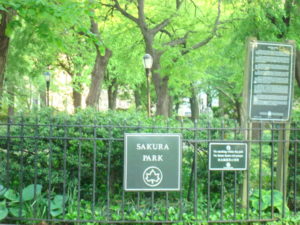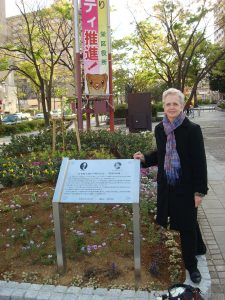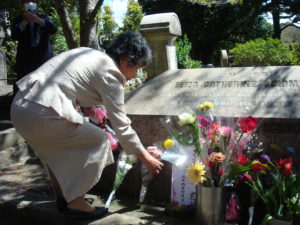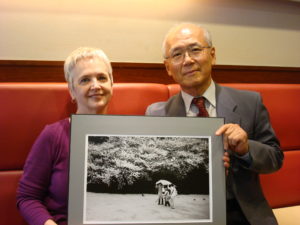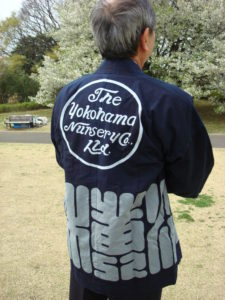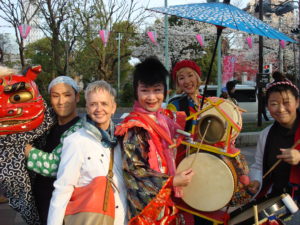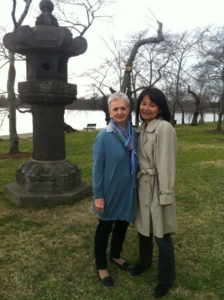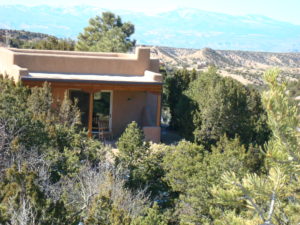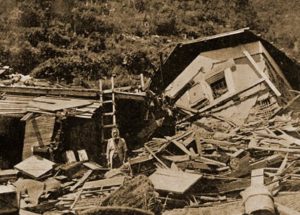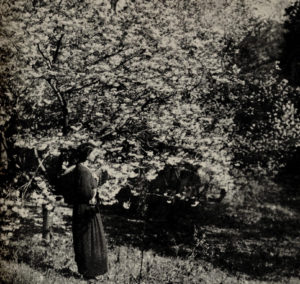Blog
In New York recently for the annual Biographers International Organization conference, I followed some research leads for my biography of Eliza Scidmore. One morning I went to the Brooklyn Museum with a writing colleague to track down an important document. Another day I took a very long walk — 80 blocks, in fact — from my hotel to W. 122nd Street. My destination was Sakura Park, on Manhattan’s Upper West Side. We hear a lot about the cherry trees Japan donated to Washington in 1912. But few people know a similar shipment of trees was planted in New York around the…
Read MoreEliza Scidmore is popping up all over the place here in Japan. Her cameo appears on plaques marking the presence of cherry tree saplings grafted from trees in Potomac Park — scions of the 3,000 flowering cherry trees that Japan sent to Washington a hundred years ago. Japan is getting a couple hundred of these saplings, with plantings at various spots around the country. The saplings have been dubbed “homecoming cherry trees.” The project is one of many activities arranged jointly by Japan and the United States to observe last year’s centennial of the first cherry trees planted in Washington.…
Read MoreWhen I started this blog a year ago (in an earlier version, titled A Great Blooming), my first post showed a photo of Eliza Scidmore‘s grave in Yokohama. A Japanese friend of mine in America, Miho Kinnas, sent the picture after visiting the site on a trip to Japan. Scidmore is buried in the Foreign General Cemetery, in the Yamate area of Yokohama. I got the photo from Miho soon after starting work on a biography of Scidmore. I knew I’d have to visit Japan (for the first time) to do research and visit Scimdore’s grave. Today, I joined members…
Read MoreLast Saturday (March 30), NHK television in Japan aired a 15-minute evening news special on cherry blossoms in which I was interviewed about my research on Eliza Scidmore. The footage included scenes of me strolling beneath cherry blossoms at Mukojima in Tokyo and visiting Eliza Scidmore’s grave in Yokohama. Among the viewers who responded was Akira Yamamoto. His chief hobby is photography, and he contacted me to offer a photo he thought I might like. It seemed to capture, he said, the real meaning of sakura (cherry blossoms) and the spirit of fellowship they generate from the shared viewing experience.…
Read MoreThat coat. I knew it at first glance. In Yokohama to do research for my book on Eliza Scidmore, I took a bus across town Friday morning to attend a ceremonial planting of dogwood trees at Honmoku Sanchou Park. The trees were among 3,000 dogwood saplings that America gave to Japan last year in exchange for Japan’s gift of 3,000 cherry trees to Washington a century ago. The mayor of Yokohama and the U.S. ambassador to Japan attended the event. But what caught my eye throughout the ceremony was the back of the Japanese gentleman who took the seat in…
Read MoreOn Saturday I literally walked in Eliza Scidmore‘s footsteps. On a crisp spring day, during my research trip to Japan, I took the train to Tokyo for cherry blossom viewing at Mukojima. Strolling and partying beneath the blooming trees reenacts an ancient Japanese tradition known as hanami (cherry tree viewing). Eliza Scidmore got her idea of planting cherry trees in Washington from the cherry-tree parks she visited in Japan, beginning in the 1880s. Every city and town had favored parks spots and gardens. Mukojima left a great impression on Scidmore. She envisioned, she wrote many times, creating a “Mukojima on…
Read MoreTime was my Valentine this year. Long blocks of uninterrupted time. I’m just back from three blissful weeks of solitude and seclusion in a cozy casita in the Sangre de Cristo Mountains outside Santa Fe, where I worked on my book about Eliza Scidmore. Amid the desolation of winter in the East, I came home recharged. And with some new ideas and answers to many questions I’d had about the daunting endeavor of writing a biography for the first time. I’m grateful to the prize-winning author James McGrath Morris and his wife, Patty, for sponsoring the residency through a Mayborn Fellowship…
Read MoreLast Friday a 7.3-magnitude earthquake struck the northeast coast of Japan, in a region known as Sanriku. The eruption, originating on the ocean floor 150 miles away, caused severe shaking but no reported deaths. The catastrophic earthquake and tsunami of March 2011, which killed about 19,000 people and caused meltdowns at the Fukushima nuclear plant, occurred in the same region. The magnitude of that earthquake was 9.0, one of the worst on record. Sanriku lies in an area of the world prone to earthquakes because of the underlying plate tectonics. More than a century ago, Eliza Scidmore reported on the…
Read MoreResearchers, authors, students and history buffs gathered here last weekend for the 39th D.C. History Conference. I was there as a presenter on Friday, in a joint appearance with Washington author Ann McClellan. The conference focuses on several major themes each year. The topics this year included the sesquicentennial of President Lincoln’s emancipation of slaves in D.C. and the centennial of the city’s Japanese cherry trees in Potomac Park. I told the story of Eliza Scidmore, emphasizing D.C. connections that have come to light in my research. Ann McClellan, the author of two books on the Cherry Blossom Festival, described…
Read More